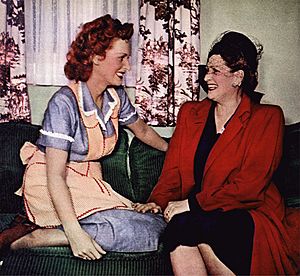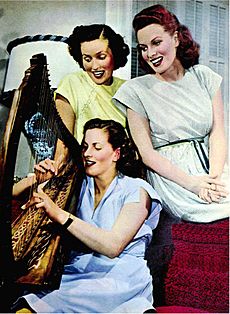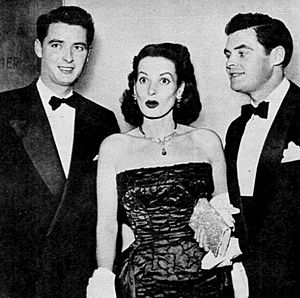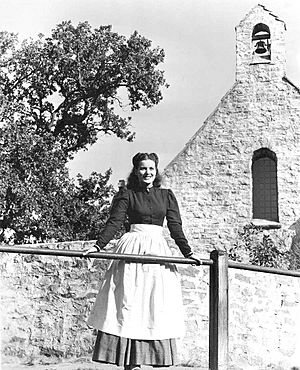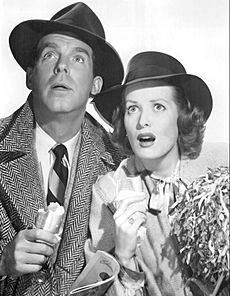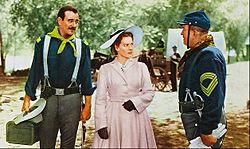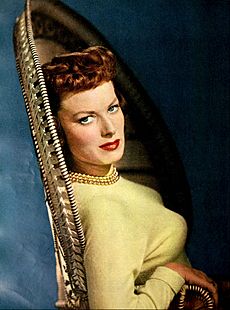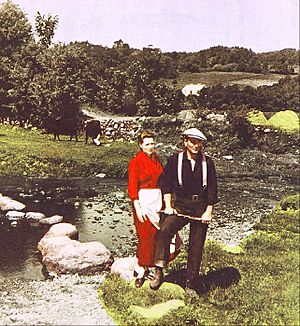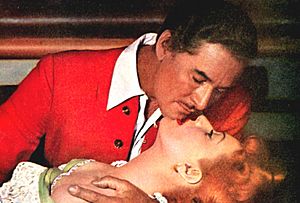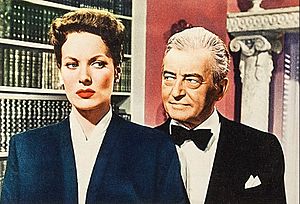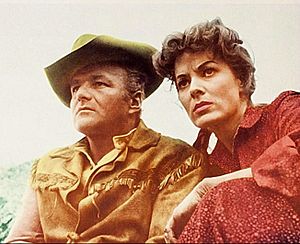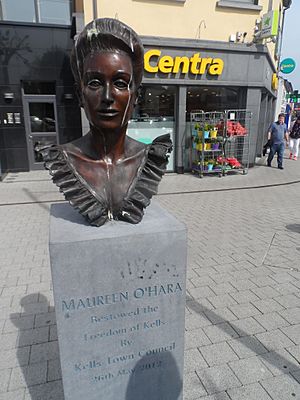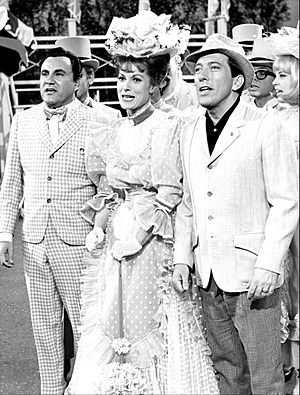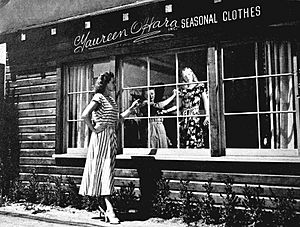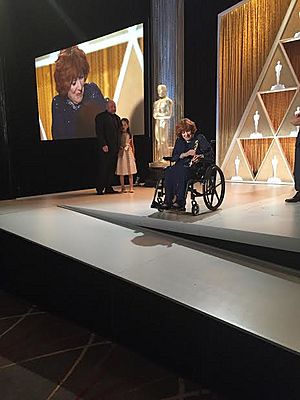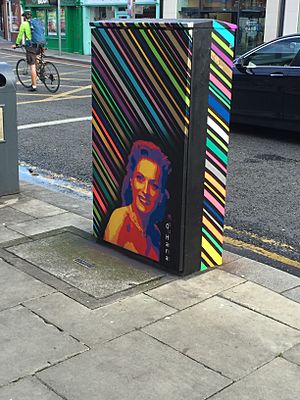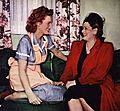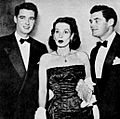Maureen O'Hara facts for kids
Quick facts for kids
Maureen O'Hara
|
|
|---|---|
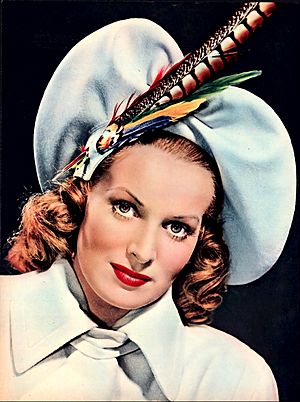
O'Hara in 1947
|
|
| Born |
Maureen FitzSimons
17 August 1920 Dublin, Ireland
|
| Died | 24 October 2015 (aged 95) Boise, Idaho, US
|
| Resting place | Arlington National Cemetery |
| Citizenship |
|
| Occupation |
|
| Years active |
|
| Political party | Republican |
| Spouse(s) |
Will Price
(m. 1941; div. 1953)Charles F. Blair Jr.
(m. 1968; died 1978) |
| Children | 1 |
Maureen O'Hara (née FitzSimons; 17 August 1920 – 24 October 2015) was a famous Irish and American actress and singer. She became very successful in Hollywood from the 1940s to the 1960s. She was known for her fiery red hair and strong personality.
Contents
Early Life and Acting Dreams
Maureen O'Hara was born Maureen FitzSimons on 17 August 1920, in Dublin, Ireland. She was the second of six children. Her father, Charles, was in the clothing business and loved soccer. Her mother, Marguerite, was a talented singer and was known for her beauty. Maureen was the only child with red hair.
Maureen loved sports as a kid. She enjoyed fishing, riding horses, swimming, and playing soccer. She even trained in judo as a teenager. She wished she had the same freedom as boys to play and explore.
At age five, Maureen started dancing. A fortune teller told her she would be rich and famous. This made her family very supportive of her acting dreams. When she was six, she performed a poem on stage and loved being in front of an audience. She trained in drama, music, and dance with her siblings.
By age 10, Maureen joined the Rathmines Theatre Company. She started acting in amateur plays in the evenings. One of her first roles was Robin Hood in a Christmas play. Her dream was to be a stage actress. At 14, she joined the famous Abbey Theatre. In 1934, at 15, she won a top acting award for her role in The Merchant of Venice. She also learned to be a typist and bookkeeper. Later, she used these skills to type the script for the movie The Quiet Man.
Becoming a Film Star
First Steps in Hollywood (1937–1940)
When Maureen was 17, she met actor-singer Harry Richman. He suggested she try out for movies in London. Maureen went with her mother for a screen test. The test didn't go well because of her heavy makeup and costume. However, the famous actor Charles Laughton saw the test. He was impressed by her expressive eyes.
Laughton and his partner, Erich Pommer, offered Maureen a seven-year contract. Maureen was very young, but her family agreed. She later said she owed her career to Mr. Pommer.
Maureen's first small film role was in Kicking the Moon Around (1938). She then made My Irish Molly (1938), using her real name, Maureen FitzSimons. In this film, she played a woman who helps an orphan.
Her first big role was Mary Yellen in Jamaica Inn (1939), directed by Alfred Hitchcock. Charles Laughton insisted she change her last name to something shorter, like "O'Mara" or "O'Hara." She chose O'Hara. Maureen played an orphan living with her aunt and uncle at a tavern. Critics praised her performance. This film made her realize how beautiful others saw her, which was different from her tomboy self-image.
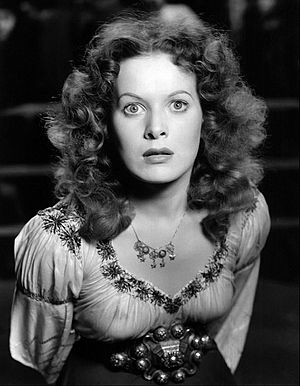
Laughton was so happy with her acting that he cast her in The Hunchback of Notre Dame (1939) in Hollywood. Maureen played Esmeralda, a gypsy dancer. She insisted on doing her own stunts, even a dangerous scene with a noose around her neck. The movie was a big success.
After this film, World War II began. Laughton sold Maureen's contract to RKO, a Hollywood studio. Maureen felt sad to be left alone in a new country. She then appeared in A Bill of Divorcement (1940) and Dance, Girl, Dance (1940). She found Dance, Girl, Dance physically tough but became good friends with co-star Lucille Ball.
Rising to Stardom (1941–1943)
In 1941, Maureen was frustrated with her roles. She begged her agent for a part in John Ford's film How Green Was My Valley (1941). This movie was about a Welsh mining family. It won the Academy Award for Best Picture. This film started a 20-year partnership between Maureen and director John Ford.
Her role as Angharad was her big break. Ford gave her the nickname "Rosebud." They had a long but sometimes difficult friendship. Maureen often visited Ford and his wife. She even said Ford once punched her, and she took it like a man. The film was highly praised, and Maureen was commended for her acting.
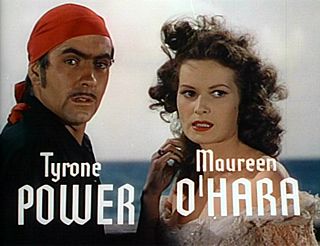
During World War II, many male actors joined the war effort. Maureen often starred in adventure films. This helped her improve her acting and stay famous.
She appeared in To the Shores of Tripoli (1942), her first film in Technicolor. It was a big success. She then played an unusual role in Ten Gentlemen from West Point (1942). Later that year, she starred with Tyrone Power in the pirate adventure The Black Swan. Maureen loved working with Power and found the film exciting. She insisted on doing her own stunts.
In 1943, Maureen played the love interest of Henry Fonda in the war film Immortal Sergeant. She then worked with George Sanders and Charles Laughton in This Land Is Mine. Her performance was seen as very effective. She also starred in The Fallen Sparrow with John Garfield. These films helped her gain more respect in Hollywood.
The "Queen of Technicolor" (1944–1949)
Maureen O'Hara was known as the "Queen of Technicolor." This was because her red hair and fair skin looked amazing in the new color film process. However, she didn't like the title. She felt it made people see her only as beautiful, not as a talented actress. The bright lights needed for Technicolor also hurt her eyes.
In 1944, she starred in the western Buffalo Bill. In 1945, she played a strong noblewoman in The Spanish Main.
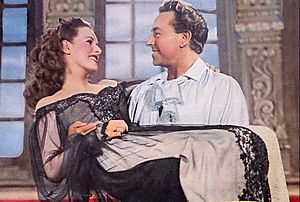
On 24 January 1946, Maureen became a citizen of the United States. She kept her Irish citizenship too.
In 1947, Maureen starred in the classic Christmas film Miracle on 34th Street. She played Doris Walker, the mother of Susan (played by a young Natalie Wood). This movie became a holiday favorite. Maureen had a special bond with Natalie Wood, who called her "Mamma Maureen."
She also appeared in The Foxes of Harrow (1947) and the comedy Sitting Pretty (1948). Critics praised her and Robert Young as a delightful on-screen couple. In 1949, she starred in A Woman's Secret and The Forbidden Street. She then made Bagdad, an adventure film that was very successful. This led to Universal Pictures buying her contract.
Working with John Wayne and Westerns (1950–1957)
In 1950, Maureen played a tough saloon owner in the western Comanche Territory. She even learned to use a bullwhip for the role.
Later that year, she was cast by John Ford in the western Rio Grande. This was the first of five films she made with John Wayne. Their on-screen chemistry was so strong that many people thought they were married in real life. Maureen said working with John Wayne felt very natural from the start.
In 1952, Maureen played Claire in At Sword's Point. This was her most physically demanding role, as she did her own stunts and trained in fencing for six weeks. She then starred in Kangaroo, filmed in Australia.
Her most famous film with John Wayne was Ford's The Quiet Man (1952). It was filmed in Cong, County Mayo, Ireland. Maureen called it her "personal favourite" film. She loved playing Mary Kate Danaher, a strong-willed Irish woman.
The Quiet Man was a huge success. Critics loved Maureen and Wayne's chemistry. Film director Martin Scorsese called it "one of the greatest movies of all time." Maureen was sad she wasn't nominated for an Oscar for her role.
Her last film of 1952 was Against All Flags with Errol Flynn. It was a successful adventure film.
In 1953, she appeared in two more westerns, The Redhead from Wyoming and War Arrow. In 1954, she starred in Malaga, filmed in Spain.
In 1955, Maureen made her fourth film with John Ford, The Long Gray Line. She also played Lady Godiva in Lady Godiva of Coventry.
In 1956, she played a villain for the first time in Lisbon. In 1957, she ended her work with John Ford in The Wings of Eagles, starring John Wayne.
Later Career and Retirement (1959–1991)
After some health issues, Maureen took a break from action films. She focused on her singing, which she loved. She had a soprano voice and appeared on many TV musical shows. In 1960, she released two albums, Love Letters from Maureen O'Hara and Maureen O'Hara Sings her Favorite Irish Songs.
In 1959, Maureen returned to films in Our Man in Havana with Alec Guinness. In 1961, she starred in the western The Deadly Companions. Later that year, she was in The Parent Trap with a young Hayley Mills. This was one of her most popular films. Maureen said Hayley Mills made the movie a success by playing two different girls so well. This film helped Maureen transition to playing mother roles.
In 1962, Maureen appeared with James Stewart in Mr. Hobbs Takes a Vacation. She felt her career was renewed after these successes. In 1963, she reunited with Henry Fonda in Spencer's Mountain. She also starred with John Wayne again in the western comedy McLintock!. Maureen did many of her own stunts in this film.
In 1965, she filmed The Battle of the Villa Fiorita in Italy. In 1966, she made her last film with James Stewart, The Rare Breed.
In 1970, Maureen starred with Jackie Gleason in How Do I Love Thee?. She then made her last film with John Wayne, Big Jake (1971). After Big Jake, Maureen retired from acting. She didn't like the direction Hollywood was taking at the time.
After 20 years, Maureen returned to acting in 1991. She starred with John Candy in the romantic comedy Only the Lonely. She played Rose Muldoon, a strong Irish mother. She said it was surprising how little had changed in filmmaking. She called John Candy "one of my all-time favorite leading men." In the following years, she appeared in several TV movies, with her last film being The Last Dance in 2000.
Personal Life and Later Years
In 1939, at 19, Maureen secretly married George H. Brown, a film producer. The marriage was ended in 1941.
In December 1941, Maureen married American film director William Houston Price. They had one daughter, Bronwyn Bridget Price, born in 1944. They divorced in 1953.
From 1953 to 1967, Maureen had a relationship with Enrique Parra, a wealthy Mexican politician. She learned Spanish and spent a lot of time in Mexico City.
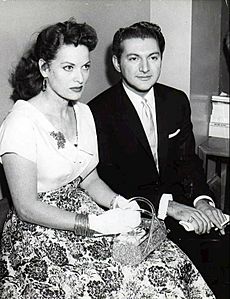
Maureen married her third husband, Charles F. Blair Jr., on 12 March 1968. Charles was a famous pilot and a former brigadier general. A few years after their marriage, Maureen mostly retired from acting to help him with his business. Charles died in 1978 in a plane crash. Maureen then became the CEO and president of his airline, Antilles Air Boats. She was the first woman to be president of a scheduled airline in the United States.
In 1978, Maureen was diagnosed with cancer. She also ran a travel magazine and a clothing store. In 1989, her home in Saint Croix was destroyed by a hurricane. While in New York, she suffered several heart attacks and had surgery.
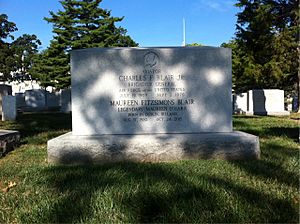
After a stroke in 2005, Maureen moved permanently to Glengarriff, Ireland. In 2012, she moved to Idaho to live with her grandson. In her final years, she had type 2 diabetes and some memory loss.
Maureen O'Hara passed away peacefully in her sleep on 24 October 2015, at the age of 95. She was buried at Arlington National Cemetery in Virginia, next to her husband Charles Blair.
Honors and Legacy
Maureen O'Hara received many honors throughout her life.
- In 1982, she received the American Ireland Fund Lifetime Achievement Award.
- In 1988, she was given an honorary degree from the National University of Ireland, Galway.
- In 1991, she received the Heritage Award from the Ireland-American Fund.
- She also won the Career Achievement Award from the American Cinema Foundation in 1985.
- Maureen was the first woman to win the John F. Kennedy Memorial Award.
- She has a star on the Hollywood Walk of Fame.
- In 1993, she was added to the Western Performers Hall of Fame and received the Golden Boot Award.
- In 1999, she was the Grand Marshal of New York City's St. Patrick's Day Parade.
- In 2004, she received a Lifetime Achievement Award from the Irish Film and Television Academy.
- She wrote her autobiography, 'Tis Herself, in 2004.
- In 2005, Irish America magazine named her "Irish American of the Year."
- In 2011, she was inducted into the Irish America Hall of Fame.
- In 2012, she received the Freedom of the Town of Kells, County Meath, Ireland, and a sculpture was unveiled in her honor.
- In 2014, the Academy of Motion Picture Arts and Sciences gave Maureen O'Hara an Honorary Oscar for her amazing career. She was only the second actress to receive this honor without a previous competitive Oscar nomination.
Images for kids
-
O'Hara in The Hunchback of Notre Dame (1939)
-
Tyrone Power and O'Hara in the trailer for The Black Swan (1942)
-
O'Hara with Paul Henreid in The Spanish Main (1945)
-
O'Hara with Liberace in 1957
-
Grave at Arlington National Cemetery
See also
 In Spanish: Maureen O'Hara para niños
In Spanish: Maureen O'Hara para niños


